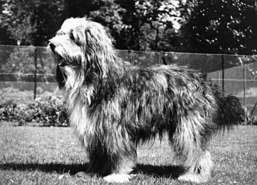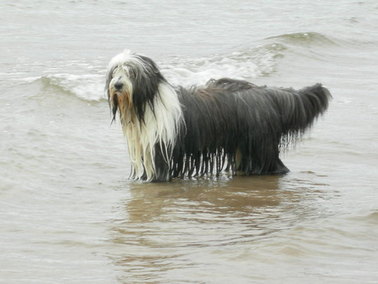Report of the UK Bearded Collie Breed Liaison Committee Health Survey 2007-2011
The Joint Bearded Collie Breed Liaison Committee Summary of the Kershaw, E., Wilkins, A., and McBride, E.Anne (2015) Report of the UK Bearded Collie Breed Liaison Committee Health Survey 2007-2012 by Elizabeth Ayrton
Introduction
The Bearded Collie was a working breed used for droving and herding, which originated in Scotland. By the beginning of the twentieth century, breed numbers were very low, and it was in the 1940s that Mrs G.O.Willison founded the Bothkennar Kennels, to which most Kennel Club registered Beardies can trace their ancestry. The breed is now kept predominantly as a pet.

Baillie of Bothkennar
This, therefore, means that the original gene pool of the present-day dogs was small. This has implications for breed health, as inbreeding was inevitable in the early days due to the small population size.
In 2006, the Companion Animal Welfare Council reported on welfare problems in pedigree animals. This report was the subject of the 2008 BBC documentary (Pedigree Dogs Exposed), which highlighted health problems in many pedigree dog breeds. Following on from this, the Bateson inquiry in 2010 looked at this issue in depth and made recommendations regarding inbreeding, inherited disease, selection for extreme morphologies, welfare, and buying and selling of dogs. One aspect that became increasingly apparent over this time was the lack of data in individual breeds. The Kennel Club did carry out a survey in 2004, which provided some data, and they repeated this at the end of 2014. The Bearded Collie Breed Liaison Committee therefore decided to run a survey in 2012, in collaboration with the University of Southampton, to collect data in order to build up a picture of health in the present-day UK Bearded Collie.

Beardie enjoying the sea
This survey was an ambitious project with data collected in 2012 on UK-owned dogs in the period from January 2007 to January 2012. Data was obtained and analysed on 700 dogs, 511 alive, 188 dead, and one respondent did not say whether her dog was alive or dead. I will briefly summarise and comment on the main aspects but refer interested readers to the whole survey, which contains more in-depth information and statistical analysis. ( see reference at the end of this report to access the survey.) These 700 dogs can be broken down into 319 males (211 entire and 108 neutered) and 379 females (192 entire and 186 neutered).
Dead dogs: Age of death varied from 1 year 5 months to 19 years 11 months, with the average being 13 years 2 months. It is encouraging to see that many of these dogs lived into their teens.
Living dogs: These varied in age from 2 months to 17 years 2 months. Data was collected looking at neutering, breeding, colour, management, exercise, mental activities, and vaccination.
Disease: 75.29% of the sample reported at least one illness (not including parasites). Dogs could be recorded as having more than one illness.

Sensory Issues
Sight: The biggest issue reported here was old age cataracts. This may or may not be correct. A normal aging process in the canine eye involves a loss of elasticity of the lens called nuclear sclerosis. This appears as a bluish cast to the eye, which to the untutored eye looks like a cataract.
Hearing: 40 dogs were reported as deaf, and 93 had temporary ear infections. The auditory nerve does deteriorate with age, so some of this deafness could be related to older dogs, and also how deafness was confirmed, hard of hearing is not the same as deaf. There was mention of deafness in relation to white and merle coats, but neither of these colours is recognised in the UK breed standard. Temporary ear infections are of concern, as are more chronic ear infections, as they can be painful and debilitating. Management has a part to play here as Beardies are prone to hair growth in the ears, which can predispose them to ear infections unless kept under control.
Dental: A range of problems were reported, but all at low levels.
Musculoskeletal problems: A range of problems were reported, the largest of which was osteoarthritis. This is not totally surprising in a breed that lives to an old age. The age of onset of osteoarthritis is a factor that is useful to monitor, as osteoarthritis in young dogs would be an area that would certainly be worthy of further investigation.
Cancers and Tumours: The incidence of individual cancers and tumours was too low to perform any analysis. 11 dogs were reported with liver cancer and 13 bitches with mammary tumours.

Autoimmune disease: 72 dogs were reported as having an autoimmune disease.

Hypothyroidism: 18 dogs were reported with this endocrine disorder.
Cushings disease: 7 dogs were reported with this endocrine disorder.
Colitis: 77 dogs were reported consisting of 34 males and 43 females.
Conclusions
This was a very ambitious survey which provided some good data to try and look at health in the UK Bearded Collie population. Hip scoring is currently the one health test required for the Bearded Collie; however, 20 dogs bred from that were not hip scored, which is disconcerting. All animals intended for breeding should be hip scored before mating. There were 2 incidents of elbow dysplasia, and this needs to be monitored, as there is a scoring system for elbows available. There are a huge number of DNA tests also becoming available for various diseases, so we need constant information to be able to choose the most appropriate tests to ensure breed health.
Eye testing of all breeding stock would monitor for inherited eye problems and could be combined with litter screening for CEA (Collie eye anomaly), where the CEA status of parents is not known.
Levels of autoimmune disease are worrying, and at present, there is still much research in this area that needs to be carried out. It would have to be strongly recommended, however, that any mating that produces puppies with AI should not be repeated. In addition, any dogs suffering from AI should not be bred from. Breeders should also avoid close inbreeding and overuse of popular sires to avoid inheritance of homozygous genes that could contribute to AI problems and also to slow down the loss of genetic diversity within the breed.
There is a need for continual health surveillance within the breed, and therefore, it is strongly recommended that Bearded Collie Clubs promote and work with the Vetcompass project, which collects data continually from participating vet practices. This could be combined with our own surveys and Kennel Club Surveys to try and monitor breed health continually and advise on any appropriate action to take
The full report is available from the main author, Dr Anne McBride, University of Southampton, or can be downloaded directly from the University of Southampton e-prints site at www.eprints.soton.ac.uk.
How to access the Survey Report
Click on the link below to open the Southampton University Eprints Website, where you can study the whole report Download (1554Kb)
If you want to remain on this page, you may prefer to right-click on the link and select Open Link in New Tab so you can view both easily.
|




